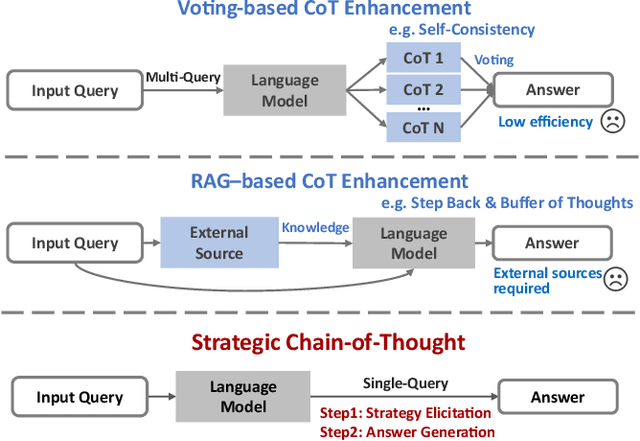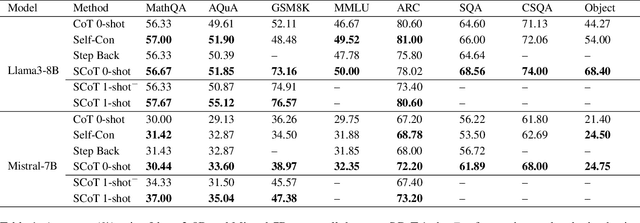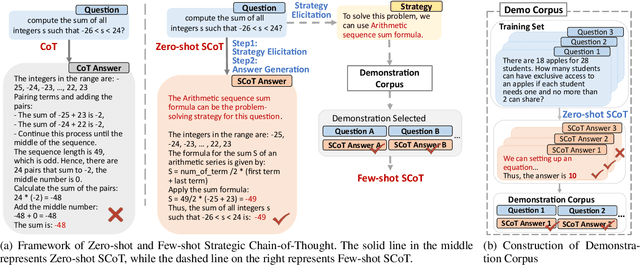Heyuan Huang
Strategic Chain-of-Thought: Guiding Accurate Reasoning in LLMs through Strategy Elicitation
Sep 05, 2024



Abstract:The Chain-of-Thought (CoT) paradigm has emerged as a critical approach for enhancing the reasoning capabilities of large language models (LLMs). However, despite their widespread adoption and success, CoT methods often exhibit instability due to their inability to consistently ensure the quality of generated reasoning paths, leading to sub-optimal reasoning performance. To address this challenge, we propose the \textbf{Strategic Chain-of-Thought} (SCoT), a novel methodology designed to refine LLM performance by integrating strategic knowledge prior to generating intermediate reasoning steps. SCoT employs a two-stage approach within a single prompt: first eliciting an effective problem-solving strategy, which is then used to guide the generation of high-quality CoT paths and final answers. Our experiments across eight challenging reasoning datasets demonstrate significant improvements, including a 21.05\% increase on the GSM8K dataset and 24.13\% on the Tracking\_Objects dataset, respectively, using the Llama3-8b model. Additionally, we extend the SCoT framework to develop a few-shot method with automatically matched demonstrations, yielding even stronger results. These findings underscore the efficacy of SCoT, highlighting its potential to substantially enhance LLM performance in complex reasoning tasks.
Re-TASK: Revisiting LLM Tasks from Capability, Skill, and Knowledge Perspectives
Aug 13, 2024Abstract:As large language models (LLMs) continue to scale, their enhanced performance often proves insufficient for solving domain-specific tasks. Systematically analyzing their failures and effectively enhancing their performance remain significant challenges. This paper introduces the Re-TASK framework, a novel theoretical model that Revisits LLM Tasks from cApability, Skill, Knowledge perspectives, guided by the principles of Bloom's Taxonomy and Knowledge Space Theory. The Re-TASK framework provides a systematic methodology to deepen our understanding, evaluation, and enhancement of LLMs for domain-specific tasks. It explores the interplay among an LLM's capabilities, the knowledge it processes, and the skills it applies, elucidating how these elements are interconnected and impact task performance. Our application of the Re-TASK framework reveals that many failures in domain-specific tasks can be attributed to insufficient knowledge or inadequate skill adaptation. With this insight, we propose structured strategies for enhancing LLMs through targeted knowledge injection and skill adaptation. Specifically, we identify key capability items associated with tasks and employ a deliberately designed prompting strategy to enhance task performance, thereby reducing the need for extensive fine-tuning. Alternatively, we fine-tune the LLM using capability-specific instructions, further validating the efficacy of our framework. Experimental results confirm the framework's effectiveness, demonstrating substantial improvements in both the performance and applicability of LLMs.
HMDN: Hierarchical Multi-Distribution Network for Click-Through Rate Prediction
Aug 02, 2024


Abstract:As the recommendation service needs to address increasingly diverse distributions, such as multi-population, multi-scenario, multitarget, and multi-interest, more and more recent works have focused on multi-distribution modeling and achieved great progress. However, most of them only consider modeling in a single multi-distribution manner, ignoring that mixed multi-distributions often coexist and form hierarchical relationships. To address these challenges, we propose a flexible modeling paradigm, named Hierarchical Multi-Distribution Network (HMDN), which efficiently models these hierarchical relationships and can seamlessly integrate with existing multi-distribution methods, such as Mixture of-Experts (MoE) and Dynamic-Weight (DW) models. Specifically, we first design a hierarchical multi-distribution representation refinement module, employing a multi-level residual quantization to obtain fine-grained hierarchical representation. Then, the refined hierarchical representation is integrated into the existing single multi-distribution models, seamlessly expanding them into mixed multi-distribution models. Experimental results on both public and industrial datasets validate the effectiveness and flexibility of HMDN.
Medical Text Simplification: Optimizing for Readability with Unlikelihood Training and Reranked Beam Search Decoding
Oct 26, 2023Abstract:Text simplification has emerged as an increasingly useful application of AI for bridging the communication gap in specialized fields such as medicine, where the lexicon is often dominated by technical jargon and complex constructs. Despite notable progress, methods in medical simplification sometimes result in the generated text having lower quality and diversity. In this work, we explore ways to further improve the readability of text simplification in the medical domain. We propose (1) a new unlikelihood loss that encourages generation of simpler terms and (2) a reranked beam search decoding method that optimizes for simplicity, which achieve better performance on readability metrics on three datasets. This study's findings offer promising avenues for improving text simplification in the medical field.
 Add to Chrome
Add to Chrome Add to Firefox
Add to Firefox Add to Edge
Add to Edge